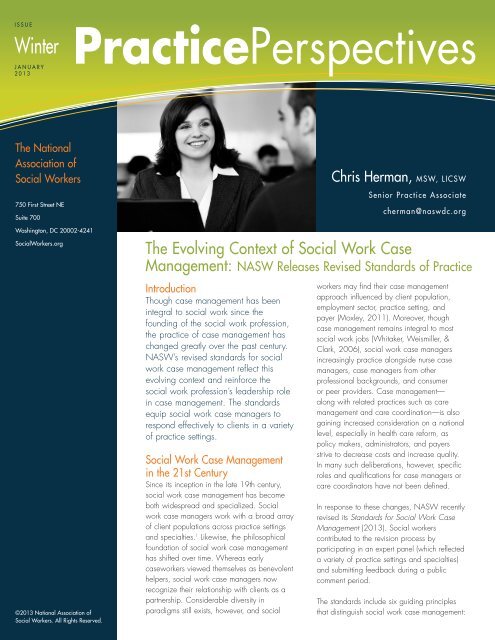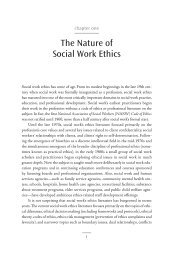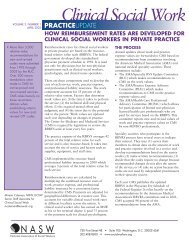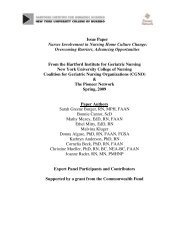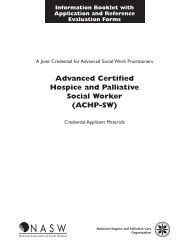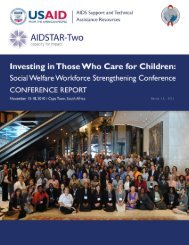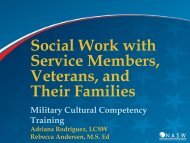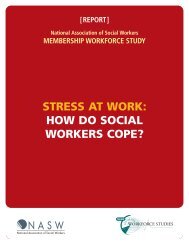The Evolving Context of Social Work Case Management - National ...
The Evolving Context of Social Work Case Management - National ...
The Evolving Context of Social Work Case Management - National ...
You also want an ePaper? Increase the reach of your titles
YUMPU automatically turns print PDFs into web optimized ePapers that Google loves.
<strong>Case</strong> <strong>Management</strong>Statistics fromNASW’s Study <strong>of</strong>Licensed <strong>Social</strong><strong>Work</strong>ers in the U.S.• <strong>Case</strong> management is one <strong>of</strong>only four tasks on whichsignificant numbers <strong>of</strong> licensedsocial workers report spendingmore than half their time(Whitaker, Weismiller, &Clark, 2006a, p. 19).• <strong>Case</strong> management agenciesare among the most commonpractice settings forgerontological social workers.<strong>Social</strong> work caseloads <strong>of</strong> 50clients or more are commonin case management agenciesserving older adults (Whitaker,Weismiller, & Clark, 2006b,pp. 22 & 24).• Among social workers inhealth care settings, 70%spend at least some time oncase management, and 15%spend more than half theirtime on case management.<strong>Social</strong> workers in bothhospitals and health clinicsrank case managementamong the top five tasks towhich they devote time onthe job (Whitaker, Weismiller,Clark, & Wilson, 2006,pp. 13–14).work case manager struggles to provide herusual quality <strong>of</strong> service to her clients, many <strong>of</strong>whom live with schizophrenia. Her colleaguesreport similar experiences. <strong>The</strong> social workerrequests a meeting with her supervisor to discussher concern. During that meeting, the casemanager identifies the most time-intensivefunctions <strong>of</strong> her job, describes how the growingcaseload size and documentation requirementshave affected service quality, and conveysanecdotal information she has gathered aboutcaseload sizes in similar programs. She reiteratesher commitment to the agency’s mission andrequests her supervisor’s assistance in decreasingcaseload size. <strong>The</strong> supervisor, who is also asocial worker, schedules a meeting with the entirecase management staff to discuss the department’sworkload. Following the meeting, the supervisorapproaches the agency administrator andadvocates that an additional case manager behired to ensure high-quality service. She alsoproposes, and <strong>of</strong>fers to chair, an internal taskforce to develop policies for determining andmaintaining caseload size. <strong>The</strong> task force, whichincludes direct practice employees, incorporatesin its recommendations data from both theagency’s own program evaluations and thepr<strong>of</strong>essional literature. 4, 5PROFESSIONAL DEVELOPMENT ANDCOMPETENCE. A social work case managerwith a decade <strong>of</strong> experience in HIV/AIDS workis qualified to practice without supervision butparticipates in ongoing continuing education andseeks supervision or consultation as needed. Shehas a growing number <strong>of</strong> clients who are AmericanIndian or Alaska Native. <strong>The</strong> social worker haslittle experience with these groups and recognizesshe needs to boost her knowledge and skills. Sheturns to the social work literature and also seeksinformation from reliable sources, such as theIndian Health Service, the Centers for DiseaseControl and Prevention, and the <strong>National</strong> Institutes<strong>of</strong> Health. <strong>The</strong> case manager also enrolls, withsupport from her employer, in a continuingeducation course on culturally competent practicewith American Indians and Alaska Natives(AI/AN). This course links her with other socialworkers with personal or pr<strong>of</strong>essional interest andexperience in the topic. <strong>The</strong> social worker joins anetwork devoted to improving AI/AN health careand, over time and in collaboration with hernetwork colleagues, becomes a trusted resource onthe topic both within and beyond her organization.Conclusion<strong>Case</strong> management constitutes a core function <strong>of</strong>,and specialty within, social work practice. <strong>Social</strong>work case management has evolved, and willcontinue to grow, in response to changes in bothpractice and policy. <strong>The</strong> NASW Standards for<strong>Social</strong> <strong>Work</strong> <strong>Case</strong> <strong>Management</strong> (2013) exemplifythese changes, highlighting the principles andelements integral to social work case managementacross client populations and practice settings.Visit www.socialworkers.org/practice/naswstandards/<strong>Case</strong><strong>Management</strong>Standards2013.pdfto download and print the NASW Standards for<strong>Social</strong> <strong>Work</strong> <strong>Case</strong> <strong>Management</strong>. Single copiesor bulk orders are available from the NASWPress (www.naswpress.org/publications/standards/index.html).1See, for example, Austin & McClelland, 2009; Berger,2009; Giddens, Ka‘opua, & Tomaszewski, 2009;Lightfoot, 2009; Mather & Hull, 2009; Moxley, 2009;Rapp, 2009; Ritter, Vakalahi, & Kiernan-Stern, 2009;Sullivan, 2009; Vanderplasschen, Wolf, Rapp &Broekart, 2007; and Walsh, 2009.2Resources addressing the client–social work casemanager relationship include Stanhope & Solomon’s2009 publication on the consumer-provider relationshipand Kondrat & Early’s 2010 article on the workingalliance in mental health case management.3Articles by C. A. Rapp (2008), R. C. Rapp (2007),and Sullivan (2009) expand on strengths-basedcase management.4<strong>Social</strong> work case managers may find the <strong>Case</strong><strong>Management</strong> <strong>Case</strong>load Concept Paper, published jointlyby the NASW and the <strong>Case</strong> <strong>Management</strong> Society <strong>of</strong>America and NASW (Craig & Stanton, 2008), useful indeliberations regarding caseload and workload inhealth, behavioral health, and compensation settings.<strong>The</strong> <strong>Case</strong>load Capacity Calculator (CLC), which buildson both the 2008 NASW–CMSA concept paper and a2011 survey <strong>of</strong> NASW members, may also be useful tosocial workers working within health plans or in acute,inpatient hospitals. <strong>The</strong> CLC s<strong>of</strong>tware, developed byConsulting <strong>Management</strong> Innovators, Inc. (CMI) andavailable free <strong>of</strong> charge at www.socialworkers.org/caseloadcalculator, allows users to downloadcomparison data regarding caseload ratios <strong>of</strong> casemanagers in similar settings. <strong>The</strong> s<strong>of</strong>tware does not,however, identify recommended caseload ratios.5<strong>Social</strong> worker self-care, addressed in the ethics section<strong>of</strong> the revised case management standards, may alsobe affected by an unsustainable workload. Please referto NASW’s policy statements addressing pr<strong>of</strong>essionalself-care (2012a) and pr<strong>of</strong>essional impairment (2012b)for additional information. See also the NASW Centerfor <strong>Work</strong>force Studies report, Stress at <strong>Work</strong>: How Do<strong>Social</strong> <strong>Work</strong>ers Cope? (Arrington, 2008).
ReferencesArrington, P. (2008). Stress at work: How do socialworkers cope? [NASW membership workforce study].Retrieved from <strong>National</strong> Association <strong>of</strong> <strong>Social</strong> <strong>Work</strong>erswebsite: http://workforce.socialworkers.org/whatsnew/stress.pdfAustin, C. D., & McClelland, R. W. (2009). <strong>Case</strong>management with older adults. In A. R. Roberts(Ed.-in-Chief), <strong>Social</strong> workers’ desk reference(2nd ed., pp. 796–801). New York: OxfordUniversity Press.Berger, C. S. (2009). <strong>Social</strong> work case managementin medical settings. In A. R. Roberts (Ed.-in-Chief),<strong>Social</strong> workers’ desk reference (2nd ed., pp.790–796). New York: Oxford University Press.Craig, K., & Stanton, M. (Eds.). (2008). <strong>Case</strong>management caseload concept paper: Proceedings<strong>of</strong> the <strong>Case</strong>load <strong>Work</strong> Group, a joint collaboration<strong>of</strong> CMSA and NASW. Retrieved from <strong>National</strong>Association <strong>of</strong> <strong>Social</strong> <strong>Work</strong>ers website:www.socialworkers.org/practice/aging/<strong>Case</strong>load%20Concept%20Paper%20final.pdfGiddens, B., Ka’opua, L.S.I., & Tomaszewski, E. P.(2009). HIV/AIDS case management. In A. R. Roberts(Ed.-in-Chief), <strong>Social</strong> <strong>Work</strong>ers’ desk reference (2nded., pp. 801–807). New York: Oxford University Press.Kondrat, D. C., & Early, T. J. (2010). An exploration<strong>of</strong> the working alliance in mental health casemanagement. <strong>Social</strong> <strong>Work</strong> Research, 34, 201–211.Lightfoot, E. (2009). <strong>Case</strong> management policies andprograms with the developmentally disabled. In A. R.Roberts (Ed.-in-Chief), <strong>Social</strong> workers’ desk reference(2nd ed., pp. 759–764). New York: OxfordUniversity Press.Mather, J. H., & Hull, G. H., Jr. (2009). <strong>Case</strong>management and child welfare. In A. R. Roberts(Ed.-in-Chief), <strong>Social</strong> workers’ desk reference (2nded., pp. 765–769). New York: Oxford University Press.Moxley, D. P. (2009). <strong>Case</strong> management inpsychosocial rehabilitation. In A. R. Roberts(Ed.-in-Chief), <strong>Social</strong> workers’ desk reference (2nded., pp. 770–778). New York: Oxford University Press.Moxley, D. P. (2011). <strong>Case</strong> management. In D. R.Maki & V. M. Tarvydas (Eds.), <strong>The</strong> pr<strong>of</strong>essionalpractice <strong>of</strong> rehabilitation counseling (pp. 269–296).New York: Springer Publishing Company, LLC.<strong>National</strong> Association <strong>of</strong> <strong>Social</strong> <strong>Work</strong>ers. (2013).NASW standards for social work case management.Retrieved from www.socialworkers.org/practice/naswstandards/<strong>Case</strong><strong>Management</strong>Standards2013.pdf<strong>National</strong> Association <strong>of</strong> <strong>Social</strong> <strong>Work</strong>ers. (2012a).Pr<strong>of</strong>essional self-care and social work. <strong>Social</strong> workspeaks: <strong>National</strong> Association <strong>of</strong> <strong>Social</strong> <strong>Work</strong>erspolicy statements, 2012–2014 (9th ed., pp.267–271). Washington, DC: NASW Press.<strong>National</strong> Association <strong>of</strong> <strong>Social</strong> <strong>Work</strong>ers. (2012b).Pr<strong>of</strong>essional impairment. <strong>Social</strong> work speaks:<strong>National</strong> Association <strong>of</strong> <strong>Social</strong> <strong>Work</strong>ers policystatements, 2012–2014 (9th ed., pp. 262–266).Washington, DC: NASW Press.Rapp, C. A. (2009). A strengths approach to casemanagement with clients with psychiatric disabilities.In A. R. Roberts (Ed.-in-Chief), <strong>Social</strong> workers’ deskreference (2nd ed., pp. 778–783). New York:Oxford University Press.Rapp, R. C. (2007). <strong>The</strong> strengths perspective:Proving “my strengths” and “it works.” <strong>Social</strong> <strong>Work</strong>,52, 185–186.Ritter, J. A., Vakalahi, H.F.O., & Kiernan-Stern, M.(2009). 101 careers in social work. New York:Springer Publishing Company, LLC.Stanhope, V., & Solomon, P. (2009). <strong>The</strong> consumerprovider-relationship within case management. InA. R. Roberts (Ed.-in-Chief), <strong>Social</strong> workers’ deskreference (2nd ed., pp. 807–811). New York:Oxford University Press, Inc.Sullivan, W. P. (2009). <strong>Case</strong> management withsubstance-abusing clients. In A. R. Roberts (Ed.-in-Chief),<strong>Social</strong> workers’ desk reference (2nd ed., pp.784–789). New York: Oxford University Press.Vanderplasschen, W., Wolf, J., Rapp, R. C., &Broekaert, E. (2007). Effectiveness <strong>of</strong> different models<strong>of</strong> case management for substance-abusing populations.Journal <strong>of</strong> Psychoactive Drugs, 39, 81–95.Walsh, J. (2009). Clinical case management. InA. R. Roberts (Ed.-in-Chief), <strong>Social</strong> workers’ deskreference (2nd ed., pp. 755–759). New York:Oxford University Press.Whitaker, T., Weismiller, T., & Clark, E. (2006a).Assuring the sufficiency <strong>of</strong> a frontline workforce: Anational study <strong>of</strong> licensed social workers. Executivesummary. Retrieved from <strong>National</strong> Association <strong>of</strong> <strong>Social</strong><strong>Work</strong>ers website: http://workforce.socialworkers.org/studies/nasw_06_execsummary.pdfWhitaker, T., Weismiller, T., & Clark, E. (2006b).Assuring the sufficiency <strong>of</strong> a frontline workforce: Anational study <strong>of</strong> licensed social workers. Specialreport: <strong>Social</strong> work services for older adults. Retrievedfrom <strong>National</strong> Association <strong>of</strong> <strong>Social</strong> <strong>Work</strong>ers website:http://workforce.socialworkers.org/studies/aging/aging.pdfWhitaker, T., Weismiller, T., Clark, E., & Wilson, M.(2006). Assuring the sufficiency <strong>of</strong> a frontlineworkforce: A national study <strong>of</strong> licensed social workers.Special report: <strong>Social</strong> work services in health caresettings. Retrieved from <strong>National</strong> Association <strong>of</strong> <strong>Social</strong><strong>Work</strong>ers website: http://workforce.socialworkers.org/studies/health/health.pdfNASW’s revisedstandards forsocial work casemanagement reflectthe evolving practiceand policy contextand reinforce thesocial workpr<strong>of</strong>ession’sleadership role incase management.
Center for <strong>Work</strong>force Studies & <strong>Social</strong> <strong>Work</strong> Practice Recent PublicationsChildren & Families• <strong>Social</strong> <strong>Work</strong> Services with Parents: How Attitudes andApproaches Shape the RelationshipClinical <strong>Social</strong> <strong>Work</strong>• 2012 Medicare Updates for Clinical <strong>Social</strong> <strong>Work</strong>ers• Clinical <strong>Social</strong> <strong>Work</strong>ers and 5010: Frequently Asked Questions• Clinical <strong>Social</strong> <strong>Work</strong>ers Be Aware: Version 5010 is Coming• Documenting For Medicare: Tips For Clinical <strong>Social</strong> <strong>Work</strong>ers• Retiring? Tips For Closing Your Private Practice• Risk <strong>Management</strong> In Clinical PracticeEducation• Addressing the Educational Needs <strong>of</strong> Older Youth• Gangs: A Growing Problem in SchoolsLeadership and Organizations• Beyond Survival: Ensuring Organizational Sustainability• NASW Leadership in Palliative & Hospice <strong>Social</strong> <strong>Work</strong>• Organizational Integration <strong>of</strong> Cultural Competency:Building Organizational Capacity to Improve ServiceDelivery to Culturally Diverse Populations• Organizing For Office SafetyPoverty• <strong>The</strong> Affordable Care Act: Implications for Low andModerate-Income Women’s Health and Well-Being• Overcoming Economic Hardships<strong>Work</strong>force & Career Development• Accountable Care Organizations (ACOs): Opportunitiesfor the <strong>Social</strong> <strong>Work</strong> Pr<strong>of</strong>ession• Career Coaching: A Valuable Resource For <strong>Social</strong> <strong>Work</strong>ers• Furthering Your <strong>Social</strong> <strong>Work</strong> Education: Obtaining A Doctorate• Negotiating A Higher Salary• Networking: Finding Opportunities for Career Development• Securing <strong>The</strong> <strong>Social</strong> <strong>Work</strong> Job You Seek: Advice For <strong>The</strong>Interview Process• Setting and Maintaining Pr<strong>of</strong>essional Boundaries• State Health Insurance Exchanges: What <strong>Social</strong> <strong>Work</strong>ersNeed to Know• <strong>The</strong> Value Of <strong>Social</strong> <strong>Work</strong> Mentoring• Transitioning Across State Lines: Licensing Tips Beyond9 To 5: <strong>Work</strong>ing As A ConsultantPractice Perspectives Winter January 2013750 First Street NE, Suite 700Washington, DC 20002-4241<strong>Social</strong><strong>Work</strong>ers.org


